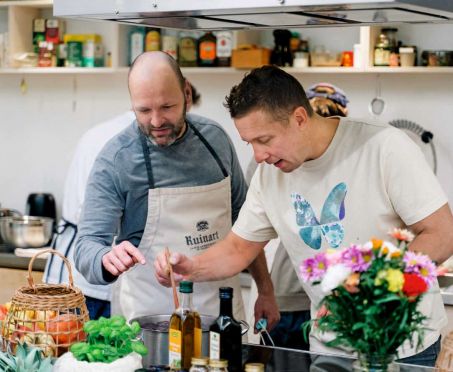When Jeppe Hein reinterprets tableware, etiquette takes a hit.
And the guests fall back into childhood, in a joyful regressive atmosphere.
Because they are authorized, and even encouraged, by the Danish artist with the face as young as he is playful, to have fun with food. At least the time of a Parisian dinner organized by the champagne house Ruinart to present its new artistic collaboration.
In the unfinished decor of the Palais de Tokyo, the long tables are laid with string… with a large brush placed next to the cutlery, to spread the sauce. The white tablecloths are punctuated with colorful touches: small blocks of concrete or expanded foam? No, meringues to be broken with wooden mallets at the end of the meal. Inside, papers hidden by Jeppe Hein with little words like “You Are Magic for Me” or “Right Here, Right Now”. This second expression is the name of the work imagined for Ruinart by the forties with sparkling light blue eyes. She takes up the principles that are dear to her: to make the public interact so that they become part of the creation and refocus on the five senses.
“Welcome to your own experience!” launches Jeppe Hein with his infectious enthusiasm, before showing the modus operandi: reaching out into a hole in the middle of mirrors of various shapes to delicately receive a raisin to be savored very slowly, a drop of essential oil, evoking the flower of chardonnay, and a piece of chalk, extracted from the Ruinart cellars in Reims. The latter then allows you to draw, in the bubbles drawn on the colorful walls, your mood in the manner of smileys. The artistic carte blanche given to Jeppe Hein is accompanied by his reinterpretation of a jeroboam of rosé, in a limited edition of 25 copies: the silent label looks like a small mirror and recalls the bubbles of champagne.
The Right Here, Right Now installation is presented throughout the year at major contemporary art fairs around the world. But it is also an invitation to take an inner journey, that of meditation. A practice that encourages being in the present moment, here and now. Jeppe Hein adopted the mantra “Right Here, Right Now”, tattooed on his left forearm ten years ago after a burnout. He considers today that this ordeal is both the worst thing that has happened to him, but also one of the most beautiful. “I lost control of my life at the end of 2009, at the age of 35. I then went through a depression which led me to undergo therapy, take up yoga and meditation. I regained calm facing my fears and I questioned everything in my life to be more authentic with myself. I asked myself: do I continue the art or do I choose to teach yoga? My mother told me said there are a lot of yoga teachers but few people doing what I do…”
His parents, teachers he describes as hippies, introduced him to art on the organic farm where he grew up, by the sea. The young man studied, from 1997 to 2003, at the Royal Danish Academy of Arts in Copenhagen.
He becomes one of the first assistants of a future figure of contemporary art, the Icelandic-do-Danish Ólafur Elíasson.
Which is still a source of influence and inspiration, especially in the playfulness of his work. Like his eldest, Jeppe Hein also has a studio in Berlin, with a chef who prepares the meals shared by the whole team. Around twenty employees work in a former industrial building transformed into an art gallery, with a vegetable garden and beehives on the roof. Jeppe Hein also likes to isolate himself in his refuge in the Berlin forest of Grunewald.
“What I appreciate above all is nature, he says. I love hiking, walking on the beach, surfing, or at least trying to surf! And doing retreats to meditate.” According to him, meditation brings a deeper and even spiritual dimension to his work: “In reality, it was already present, without appearing clearly, because I realized that fifteen years ago I had already called Enlighten-ment works [illumination]. When I was younger… than now, I was associated with minimal art, but now I don’t know what movement I can be compared to.
My way of approaching art is for people to feel part of the work and its energy. I want to generate empathy and make people smile.” He also likes to cause surprise. On the artistic route between Nantes and Saint-Nazaire, along the Loire estuary, a 20-meter water jet, called Did I Miss Something?, arises when walkers sit down on the bench opposite.
In 2002, for the inauguration of the exhibition space of his German gallery owner Johann König, Jeppe Hein had placed a metal sphere on the ground which began to move and hit the walls as soon as someone entered the room. . Conversely, some works come alive when visitors leave. An aquatic labyrinth of fountains or a maze of mirrors are recurring figures, as are the benches in the Modified Social Benches series. Between sculpture and urban furniture, they show off all the colors and take the candidates for the seat out of their comfort zone, with their unbridled shapes: mini-roller coasters, toboggan, staircase or bridge that spans the gate of a square… adults and children alike do not remain indifferent and are thus led to socialize.
For his new major solo exhibition, Who Are You Really?, scheduled until the end of the summer at the Moderna Museet in Stockholm, Jeppe Hein has taken up the challenge of not moving existing works in order to limit transport and therefore the carbon footprint. Hence the call for the participation of the public who entrust mirrors staged by the artist in a part of the museum. While visitors are guided through seven steps to try to better define and discover themselves: “I am”, then “I feel”, etc. And you, who are you really?
“I am Jeppe; I am 80% water and 20% chocolate; I am a sensitive and creative man with an open mind and heart; I am both fragile and willful; I am dyslexic but skilful with the words.” Hence his suggestion “Please Touch the Art”, contrary to the prohibitions usually displayed next to the works. Touching and being touched by emotion, such is his proposal.
Meeting with a chef organized by Ruinart with “Food for Art”.
Jeppe Hein received five in his Berlin studio to develop dinner events in Europe and Japan.
(J. Jungbauer)
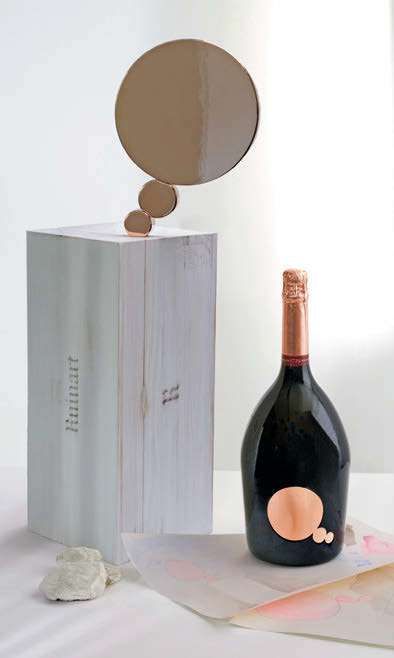
Jeroboam of rosé champagne. Jeppe Hein sanded the box with chalk from the Ruinart cellars and transformed the label into a mirror.
(MH Studio)
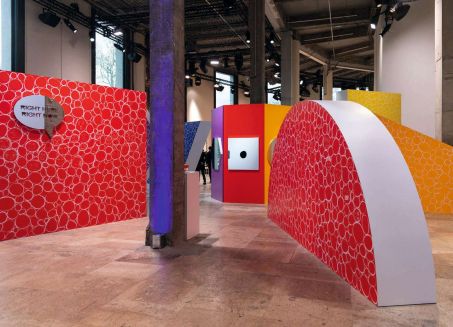
The installation Right Here, Right Now, inaugurated at the beginning of April at the Palais de Tokyo in Paris. Created by Jeppe Hein, it travels throughout the year to major international contemporary art fairs.
(J. Piatti)
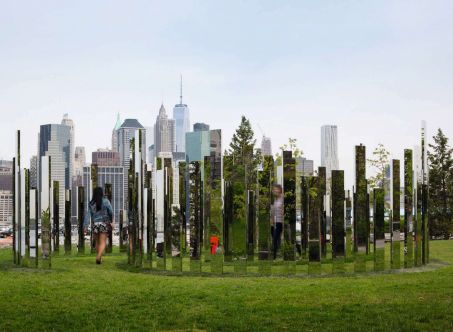
(Studio Jeppe Hein)
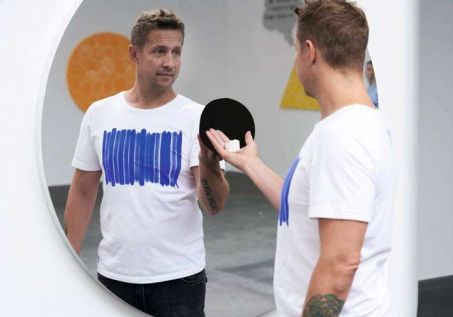
Game of mirrors. Jeppe Hein uses mirrors to create a labyrinthine effect, as in New York in 2015 (top), or a confrontation with oneself, as above for his collaboration with Ruinart: the hand passed through the hole receives a piece of chalk, a grape or a drop of essential oil.
(J. Strempel Photography)
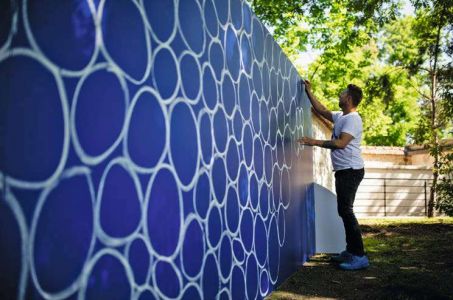
(Mr. Bonnevie)
APPOINTMENT
Exhibitions
– The installation designed for Ruinart will be presented at several contemporary art fairs this year, including Art Basel, in Basel, from June 16 to 19, and Fiac, in Paris, from October 20 to 23.
– At the Moderna Museet in Stockholm (www.modernamuseet.se), Jeppe Hein imagined the exhibition Who Are You Really?, scheduled from May 21 to August 28.
Site (s
– jeppehein.net, official website of Jeppe Hein.
– jeppehein.ruinart. com, virtual experience around creation for Ruinart.
Par Stéphanie Condis
We would like to give thanks to the author of this post for this incredible web content
The secrets of Jeppe Hein’s collaboration with the Ruinart house – Teller Report
Check out our social media accounts as well as other related pageshttps://nimblespirit.com/related-pages/

